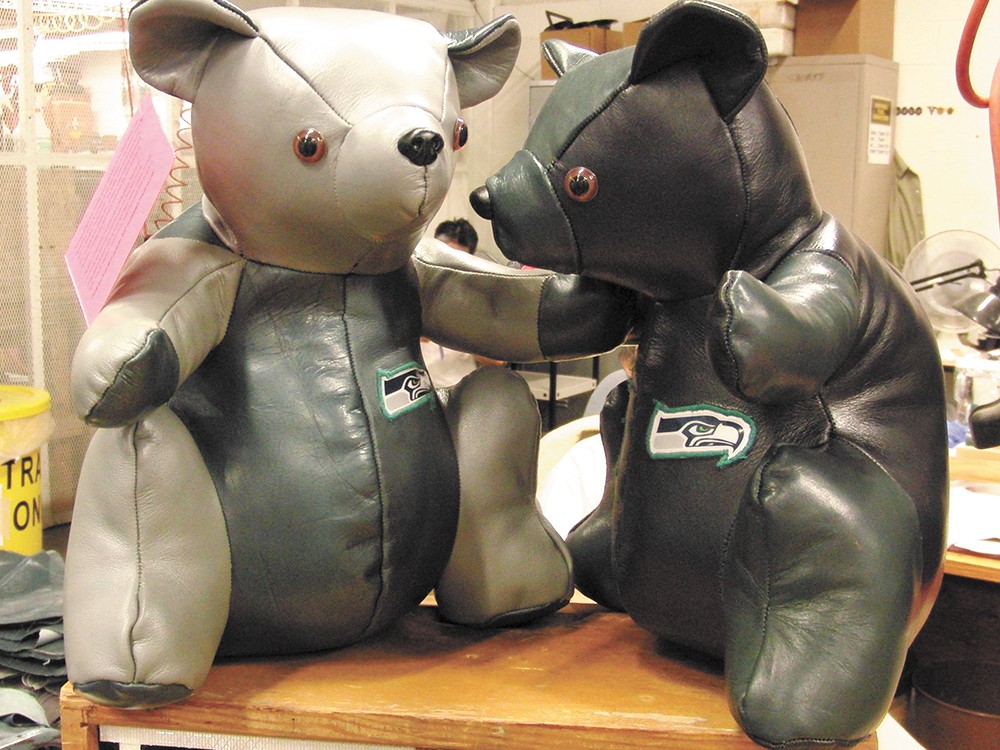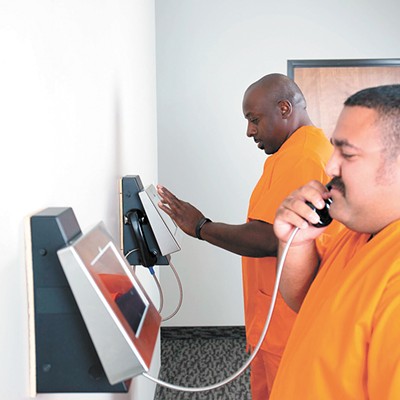Amid the clank, whir and jangle of machinery sits a man, feeding rectangular metal plates into a large industrial press. On the other side of the press another man is selecting numeral-shaped dies. Nearby, a third man stacks freshly-embossed license plates. The factory produces 3 million license plates a year — every plate issued in Washington is made here — and it looks like a typical manufacturing operation. It's not. The employees here earn less than a dollar an hour and are inmates incarcerated at the Washington State Penitentiary in Walla Walla.
"I could be sitting in a [human] warehouse or doing something useful," says inmate employee Jeremy John, who appreciates the opportunity to get out of his cell and do something productive with his days. He's been working here for four years while serving a six-year sentence. "I'm a couple weeks from the gate," says John, who plans to parlay the skills he has gained while working in the prison factory into a job on the outside.
Prison labor is a billion-dollar industry in the United States, with 67,000 inmate workers at 542 prisons nationwide. Washington's Correctional Industries is the fourth largest, employing around 2,000 inmates — including 307 at the Washington State Penitentiary — and paying them between 55 cents and $1.60 per hour. Correctional Industries' brochures declare the Washington Department of Corrections-owned business' mission statement: to develop prisoners' marketable job skills, instill and promote positive work ethics and reduce the tax burden of corrections.
Critics, however, question whether the program has accomplished any of those goals. Meanwhile, small business owners say they would be doing more business — and hiring more employees on the outside — if they weren't forced to compete with Correctional Industries for lucrative state contracts.
"There's a provision that allows Correctional Industries to sell to any state agency without a formal bid process, if they go and say they can service a state agency's uniform program, that industry is almost required to buy," says Mitch Blumenthal of Blumenthal Uniforms, who testified before the state Legislature about shoddy workmanship in Correctional Industries' prison guard uniforms. If agencies want to shop elsewhere, they have to extensively document issues with the prison-produced products, Blumenthal says. "They have an unfair advantage, and there's no oversight in the pricing they're charging."
Blumenthal says that Correctional Industries doesn't even make some of the products they sell. "They'll buy them from a retailer like us, add a markup and sell them to the state," says Blumenthal. "We'd definitely be doing more business if there was no Correctional Industries; we'd have another 10 employees."
DOC's Maria Peterson says the offenders who participate in these programs return to their communities as more productive citizens. "The goal is for offenders to get out better than they came in. If they have more education and job skills, they are less likely to reoffend," says Peterson. But are the skills offenders gain working in Correctional Industries' factories, making furniture and sewing uniforms, really valuable in the modern job market?
Blumenthal doesn't think so. "Garments are made overseas or in Mexico these days," he says. His company doesn't sew garments locally, and the tailoring positions he does have require skills that far surpass the rudimentary garment-making skills Correctional Industries teaches inmates. "It's not a trade that will provide a lot of skills you can use here today; they'd be better suited with tech skills."

Donny Weaver, who oversees the license plate shop, says offenders do learn tech skills in his shop. They use software like AutoCAD and sophisticated CNC routers and fabrication equipment. But Paul Wright, executive director of the Human Rights Defense Center and the editor of Prison Legal News, says that historically, prison industry programs have been faulted for giving the most skilled jobs to inmates who won't be released anytime soon.
Inmate Keith Parkins teaches inmates how to recycle, sew and compost in the Sustainable Practices Lab at the state penitentiary. Unfortunately, he won't be able to use the leadership skills he's developed here in the real world: He's serving a life sentence. Prison labor programs are often criticized for employing too many lifers, but Correctional Industries' Lindsey Konrad says that's not the case with her program. "We can't have more than the percentage of [prisoners serving] life without [parole] than is at the facility; whatever that percentage is, is the max we can have in our shop," says Konrad.
But Correctional Industries has been reprimanded for violating this requirement in the past: A September 2013 internal audit found up to 12 times the allowed number of lifers working at some facilities. Washington State Penitentiary public information officer Shari Hall says that 28 of the current 307 Correctional Industries workers at Walla Walla are serving life sentences, and another 50 will be there for more than a decade. Labor and human rights advocates liken the use of this captive workforce to slavery.
"When this happens in China, we call it a human rights violation," says Wright. "But here it's supposedly a great rehabilitation program."
Rob Branscum, who manages the Sustainable Practices Lab, doesn't see it that way: giving prisoners — even those serving life sentences — jobs gives them a renewed sense of purpose and cuts down on conflicts. It helps the entire facility run more smoothly.
Correctional Industries business manager Todd Cunnington says there are other benefits to prison manufacturing programs. "The goal is to reduce the overall tax burden," says Cunnington.
But Wright says that's a misnomer. "The biggest losers are taxpayers: Every time prison industries programs are audited, they are losing money," says Wright. "You're like, 'Gosh, they're paying so little, how could they be losing money?' But the bloated bureaucracy and prison staff required to oversee these programs are where they're hemorrhaging."
Correctional Industries sells as much as $70 million worth of furniture, uniforms and other goods to state agencies each year, but a 2014 investigation by the Seattle Times found that the program has cost taxpayers more than $20 million since 2007. Some business ventures — including a tilapia farm on the coast — had lost money, and Correctional Industries had relied on the profits from their furniture and license plate businesses to gloss over the losses.
Wright says prison labor programs tend to be too heavy on staff and don't operate with the efficiency of private companies. Weaver estimates that between 35 and 40 staffers oversee the prison industry workers at Walla Walla; Correctional Industries claims to contribute "approximately $32 million per year to the Washington economy through purchases from local suppliers and payment of staff salaries."
But Konrad says that at the end of the day, the goal really isn't profits. "We have these businesses that make things," she says. "But our real mission is to train offenders and reduce the likelihood that they will return to prison."
Correctional Industries has been around since 1981, yet little data has been collected to study the program's actual efficacy at reducing recidivism. A 2005 study by the Washington State Institute for Public Policy study found that Correctional Industries had the potential to save taxpayers $4.74 per dollar spent. The program's actual effect on recidivism rates hasn't been established, though. "The data on the effectiveness, there just hasn't been a lot of research done," says Konrad.
Taxpayers end up footing the bill when state agencies are required to purchase Correctional Industries' pricey goods. On their website, a standard-looking office chair sells for $461 to $559. Similar chairs are available for as little as $169 from retailers like Staples and Amazon.com. "State agencies can buy better quality items on the open market for less," says Wright. "It depresses wages for furniture manufacturers on the outside, and the state pays more for inferior quality." ♦






















